New Scranton Times Tribune Editorial: The NIB Means Fully Funded Infrastructure "Without the Political Drama"

The following is the full text of an editorial which appeared in Scranton's Times Tribune and The Citizens' Voice on December 16, 2021.
Given national politicians’ reluctance to fund infrastructure projects outside their own districts, and the long, torturous road to passage of the $1.2 trillion infrastructure bill, the nation should embrace a systematic means to attend to the country’s infrastructure without the political drama.
A National Infrastructure Bank would pull off that feat. It would diminish the role of politics in funding crucial infrastructure projects, taking specific funding decisions out of Congress’ hands and funding projects from the bank’s own operations rather than from federal tax money.
Under the NIB proposal, the bank would be capitalized at $5 trillion over 10 years. Private investors who invest a total of $500 billion in treasury bonds in the bank each year to capitalize it would be rewarded with stock in the bank that pays 2% more than the treasury bond rate.
Local and state governments or related boards and authorities would borrow from the bank at favorable rates for projects including water systems, roads and bridges, rail, ports, airports and other elements of infrastructure. As those loans are repaid, the bank would have a revolving fund to finance new projects.
The nation has had infrastructure banks before, beginning during George Washington’s administration and most recently during Franklin Delano Roosevelt’s administration, when the bank funded infrastructure work to help fight the Great Depression.
Congress would have to create the bank. But advocates seek state legislative resolutions to help spur Congress to act. Democratic Reps. Eddie Day Pashinski of Luzerne County and Kyle Mullins of Lackawanna County have taken up the resolution effort.
The state Legislature should approve the resolution and Congress should create the bank to make infrastructure maintenance and development a systemic, rather than extraordinary, process.
